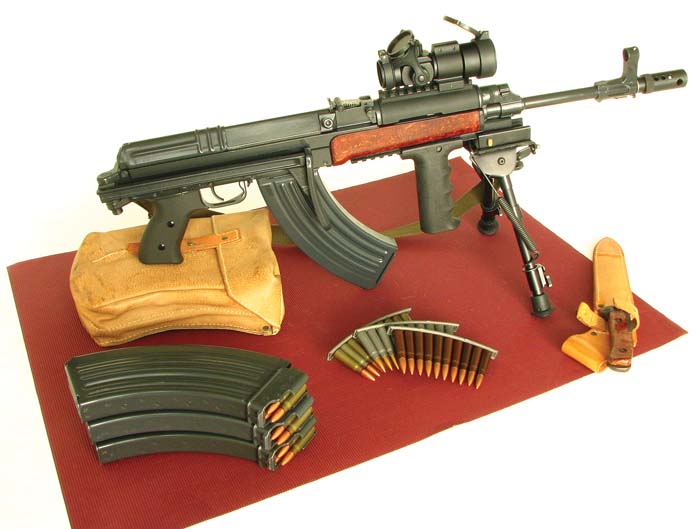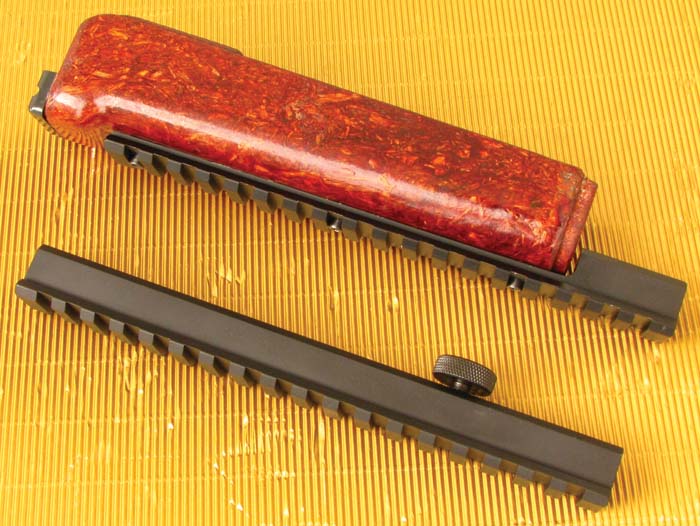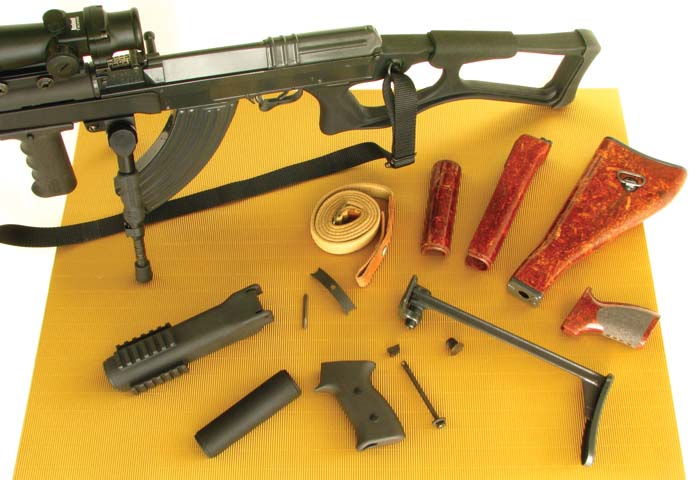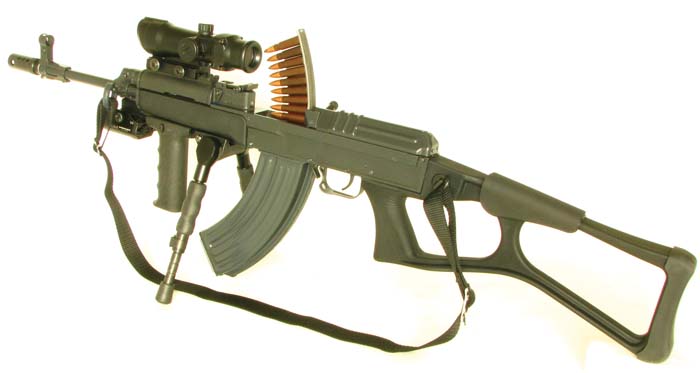By J.M. Ramos
Czechoslovakia needs no introduction. Their military hardware saw extensive use during WWII and was employed by Axis and allied forces alike. Czech weapon designers have set many standards from which many of today’s combat arms produced from around the world have evolved.
The Vzor 58 was developed and produced by Uhersky Brod Ordnance (one of the many state factories) sometime in 1958. It replaced the earlier M53/57, a semiautomatic rifle utilizing a detachable 10-shot magazine and fired the Soviet 7.62×39 AK-47 round. The Model 53/57 borrowed its gas operated system from the German MKb4(W) Sturmgewehr while the trigger mechanism is derived from the US M1 Garand. This rifle was produced in limited quantities and its adoption was short lived. The VZ-58 on the other hand, has reached its golden anniversary with the Czech armed forces and will likely stay in service for quite a while.

Early models had a wooden butt stock, foregrip and pistol grip. Later versions utilized a wood fiber-filled plastic in its furniture. The VZ-58 was produced in three versions; namely the M58-P (standard), M58-V (folding stock) and M58-Pi (Sniper). The Sniper version had a long dovetail bracket on the left side of the receiver to accept a night vision sight. This rifle is usually equipped with a light bipod and a large conical shaped flash hider. The Vzor 58 externally resembles the Soviet AK but mechanically is different. Unlike the new AKs with stamped receivers, the Czech battle rifle is still made the same old fashion way – its major components are fully machined from forgings and its overall construction is every bit as robust as the original and is the most sought after milled receiver Kalashnikovs. The Czech gun exhibits superb quality of workmanship; a trade mark of its famous maker. However, the VZ-58 lacks the charm and personality of a star battle rifle when compared to other arms in its league in the likes of the AR, AK, H&K, FN or SIG. The overall configuration is streamlined and very compact even with the fixed stock model. This short overall length is attained by incorporating a shorter butt stock than those found on standard M16 rifle. The standard barrel length is 390 mm (15.35 inches). The VZ-58 has stood the test of time with five decades of uninterrupted service to its credit. The Czech rifle was issued with bayonet and scabbard, flash hider, bipod, fabric sling, sectional cleaning rod with brush and patch holder, soft pigskin magazine pouch for four 30-round magazines, front sight adjustment tool and oil bottle.
Despite its five decades of continued service with the Czech army, the VZ-58 failed to achieve a worldwide recognition and popularity bestowed on the AK and AR. Although it remains almost unheard of in North America, the Czech gun was encountered regularly in parts of Africa, the Middle East, Central America and the Far East where rag-tag armies, mercenaries and rebel organizations thrive. The Vzor 58 was also purchased in limited quantities by Cypriot, Somalia and Sudan.
After many decades of being the most elusive military service arm most sought after by advanced Class III collectors in the US, a semiautomatic version of the Vzor rifle is finally available for the civilian market, although a very limited number of original military issue Model 58s converted to semiautomatic have been available in Europe since the 1970s and a few samples were also imported into Canada in that same time along with the Belgian FN CAL’s with burst firing mechanism removed. The US prohibited the entry of any Com-Bloc hardware until the Berlin wall come down and the collapse of the Soviet empire became a reality. The only source of these arms during the cold war era in this part of the world was Canada who maintained its neutrality between the two super powers. With its new found independence, former Com-Bloc nations are reaping the reward by being able to finally export their wares in the US and truly compete in the international market.

Commercial semiautomatic models of the VZ-58 is available both in the US and Canada. In the US, these rifles are marketed in two versions: the Vz 2000 with a longer 19-inch barrel and a compact model called Vz 2000 SBR (Short Barreled Rifle) featuring a 15.5-inch barrel (requires NFA transfer). The Vz 2000 SBR is identical in size to the original military model but with completely new trigger lockwork firing semiautomatic only. Civilian models will not accept the military full auto trigger mechanism and are normally equipped with fixed stocks. The VZ 2000s are supplied complete with an alternate folding metal stock, 4-mag pouch, cleaning kit, bayonet and sling – all original military accessories. The American versions are available from Ohio Ordnance Works, Inc. The Canadian models are available from various sources namely Marstar Canada and Wolverine Supplies. Marstar markets the restricted compact version with 390 mm barrel called the VZ-58S while Wolverine Supplies opted for the longer 482 mm (19-inch) barrel making their version a non restricted firearm. The Wolverine designation for the non restricted model was CZ-858 “Tactical” or CZH 2003 “Sport” as marked on the receiver.

As the popularity of the civilian version of the Vzor 58 began to soar in the commercial market, it is no surprise that its producer took advantage of the new market for tactical upgrading by introducing new line of accessories to include a very effective muzzle brake, black polymer skeletonized stock (that replaces the existing stock and pistol grip), a new pistol grip that is slightly larger and more ergonomic than the original, a three rail hand guard and a matching railed upper hand guard. The railed upper hand guard however did not come with a steel liner so it cannot be readily assembled.

To use this custom part, the steel liner of the regular hand guard in the gun must be removed first and transferred to the replacement guard. This procedure is a little bit tricky to do and needs a little care so as not to damage the liner. To transfer the steel liner from the issue guard to the replacement part, carefully pry the tab on each side of the liner with a small screwdriver until a long nose plier can grip and bend it straight upward. Once the two tabs are straightened up, carefully bring them closer together at the center until the two ends touch each other in the shape of a triangle. This will allow the guard to be rotated and off the liner. To install the liner to the new part, reverse the procedure as previously described. Once the liner is seated and centered to the polymer component, push the tabs back with a non marring tool or screwdriver handle against the side of the guard and carefully bend the tabs back on the underside shoulder of the new part as it originally locked with the issue part. Looking down at the top of the rail, you will see two pre-drilled holes. Use these two holes to drill through the metal liner using the exact size that fits the hole. The kit comes with two screws and matching nuts for this purpose. Once the holes are drilled, assemble the screws and nuts and cut any protruding end of the screw below the nut so it will not interfere with the barrel during assembly.
The upper hand guard may require some tightening at the rear where the retaining pin is assembled. Usually some minor side-to-side play can be encountered here depending on the gap or tolerance. Any side play on this part, minor or major will affect the accuracy of the optic which is being mounted on the top of the guard. If the gap is extremely minor, little squeezing on the vice is all that is needed but of equal pressure to maintain centrality of the part when assembled. If the side play is too much, the gap is normally excessive. A shim will be required on each side of the pin to eliminate this problem. Again, depending on the size of the gap, there are various readily available materials that can be improvised to make the shim. The shim can be cut from water bottles, pop cans, motor oil or milk jugs. These containers may vary in thickness and color and can be easily cut in circles using an empty 9mm brass sharpened on the edges. You may use a .22 shell to punch the center hole to clear the assembly pin. Once the right thickness shims are installed in the inner side wall at the rear of the liner where the assembly pin is inserted, side play is virtually eliminated. Although rare, the front end of the liner may also have some looseness or side play. This can be simply squeezed up a bit until the play is eliminated and the guard can become a solid platform for the optic. If this procedure is too much for you to handle, you can opt for the Scout Scope Mount. This accessory simply replaces the issue rear sight and the extended rail hangs over the hand guard. These accessories are all available from Wolverine Supplies. Except for accessories, firearms and parts are not importable to the US.
The matching lower hand guard features a 3-rail system, one on each side and one in the bottom. Side rails can be used for mounting lights and lasers. The bottom rail will take either a forward grip or bipod with bases that are designed to slide on rails. Ideally, these mounting platforms should run the entire length of the hand guard, which is already short to begin with. If done properly, a longer rail on the bottom will accommodate a forward grip and a bipod at the same time and not one at a time. One quick solution to achieve this requirement using the short bottom rail is by incorporating a secondary mounting rail that can take both a forward grip and bipod. The secondary rail will then be mated to the guard’s built-in bottom rail. The ideal secondary rail for this purpose is Brownells’ AR-15 flat top riser mount. This accessory is very well made and is economically priced. It is flatter than most similar items out there thus offering less bulk when mounted to the bottom guard complete with grip and bipod. The two large knurled thumb operated screws of the riser allows for a quick detach mode as one unit. This versatile set up can be universally employed to virtually any tactical type rifle, SBR or SMG with rails mounted below the forearm including the AR, AK, H&K, 1022, etc., and is quite easy to put together giving the operator the option to choose what brand or type of forward grip and bipod to combine with in creating this simple but very effective accessory.
For longer rail requirements at the bottom of the hand guard, the Peace River AR-15 Carry Handle Scope Base (available from Brownells) can be modified and adapted. This part is 7-1/2 inches long and 3/4 inch thick and is perfect for the project. It features a true 1913 Picatinny rail and is of high quality manufacture and economically priced. This part is cut lengthwise leaving about 1.325 of its front end uncut and blended quite nicely at the front of the hand guard. The hand made rail had a height of .285 inch at the rear and elevated at the base of the uncut portion to about .375 inch to provide a straight horizontal level when mounting a laser sighting device. The ultra-trim rail configuration of the modified accessory perfectly blended with the slim line format of the gun’s forearm that it seated very snuggly in place virtually eliminating unsightly bulk normally associated with most readily available bolt-on rails. Securing the rail to the hand guard are three 8-32 socket head screws. The three screws tighten up with one-piece aluminum flat .075 thick positioned on the other side of the guard like a liner. Since the guard can not be assembled to the gun with the rail pre-installed, two separate 6-32 screws keep the aluminum flat seated in place. The rail can then be installed using the three mounting screws after the hand guard is fully seated and secured to the gun. This set up allows the forward grip to be mounted as high as possible when installed to the rail providing the most comfortable shooting stance and ergonomics. The extra length of the rail permits ample space to mount three tactical accessories such as the CAA VG1 battle grip, bipod and Streamlight TLR LED flash light or Laser. The versatility and simplicity of the CAA bipod allows it to be mounted behind or in front of the forward grip. Its uncluttered design keeps the overall set up of the upgraded battle rifle sleek, foolproof and outright stunning.
The early original pistol grip of the gun closely resembled that of a revolver pattern and the new polymer grip slightly differs in configuration. It is a tad larger and superior in terms of ergonomics and styling and the textured dull surface of the black polymer accessories are excellent. They provide non slip purchase in wet or dry conditions. The built-in rails of the hand guards are reasonably well made. However, the rails lack the precision of machined aluminum or steel material. The CZ rails are somewhat oversize at the top and the upper taper on the side of the rail is steep so that an EO Tech optic will not engage the rail. Most optics equipped with a clamp on type lock are the only ones that will readily fit the rail. To fit the EO Tech to the CZ rail, the rail must be fitted to the optic’s locking mechanism.
When using optics, the fixed stock seats quite low and is a bit awkward to aim at targets. The original stock is tailored perfectly for the iron sight. To attain correct and comfortable aiming position, a straight stock is necessary. The quickest and most economical solution to correct this problem is to raise the level of the stock using Brownells’ 3/4×1 inch Scopeeze. This stick-on type accessory seats over the stock and instantly raises the elevation of the stock to correct level for comfortable aiming with optics. The only drawback to this accessory is, it is non adjustable and using the iron sight will be quite a challenge. The folding stock appears to seat just a tad higher than the fixed stock and an acceptable compromise for both optic and iron sight usage. Better yet, buy a spare and bend the metal stock straight for optic use. The ideal solution that will permit the use of both optics and the issue iron sight is the optional skeletonized butt stock. This part is made of black lightweight polymer material and perfectly matches the other tactical upgrades. It features a built-in ergonomic sniper type grip with a wrist clearance (right hand only) to permit a natural shooting hold. It has a snap-on type cheek piece with soft rubber lining for optic use. The butt stock also has a matching removable rubber cap for maximum comfort and recoil absorption. The sniper type stock is about 1-3/4 inches longer than the standard fixed and metal folding stocks. One very unique feature of the skeleton stock is how it allows the operator to adjust his shooting position from optic to iron sight instantly without the need for an adjustable check piece. The snap-on part elevates shooting posture by about half an inch, just perfect for most low mounted optics. Resting the cheek behind the elevated part positions the eye at a correct level with the iron sight. The stock design is based on a ramp principle. It is simple, effective, and it works.
As the demand and popularity of the VZ-58 semiautomatic family grows in the civilian gun market, there is no doubt CZ will accelerate its effort to creating even more unique and sophisticated tactical accessories for its best selling semiautomatic models to compete with the worlds best. With a new promising venture on the horizon, it will perhaps make up for the limited success of its military model counterpart. The VZ-58 has finally found a new beginning.
SOURCES
Ohio Ordnance Works, Inc.
P.O. Box 687
Chardon, OH 44024
(440) 285-3481
www.Ohioordnanceworks.com
Wolverine Supplies
Box 729 Virden
Manitoba, Canada ROM – 2CO
(204) 748-2454
www.Wolverinesupplies.com
Marstar Canada
Rural Route #1
Vankleek Hill, Ontario
Canada KOB – 1RO
(888) 744-0066
www.Marstar.ca
Command Arms Accessories
76 Vincent Circle
Ivyland, PA 18974
(267) 803-1002
www.Commandarms.com
Brownell’s, Inc
200 South Front Street,
Montezuma, IA 50171
(800) 264-3068
www.Brownells.com
| This article first appeared in Small Arms Review V12N3 (December 2008) |











